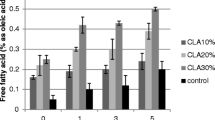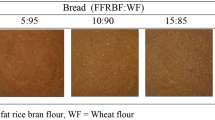Abstract
Rice bran oil is nutritionally superior oil as compared to other common vegetable oils. In the present study, six rice bran oil blends were prepared in two ratios i.e., 80:20 and 70:30 and the effect of deep-fat frying was studied by assessing changes in iodine value and fatty acid composition. Results showed that the minimum iodine value was found in the blend of rice bran oil and palm-olein oil as 107.3 g (70:30) and 107.0 g (80:20) at fresh conditions which decreased by 1.6 and 1.3 % after second frying and by 2.7 and 4.5 % after third frying respectively. The saturated: mono-unsaturated: poly-unsaturated fatty acids in the deep fried products prepared using the blend of rice bran oil and palm-olein oil was close to the recommendations as 1:1.9:1.4 and 1:1.2:1.7 in the ratio of 80:20 and 70:30 respectively. The present study concluded that the blend of rice bran oil and palm-olein oil in both ratios was the most stable frying medium among all rice bran oil blends based on changes in iodine value and fatty acid ratio under frying conditions.
Similar content being viewed by others
References
Tynek M, Hazuka Z, Pawlowicz R, Dudek M (2001) Changes in the frying medium during deep frying of food rich in proteins and carbohydrates. J Food Lipids 8:251–261
Alireza S, Tan CP, Hamed M, Che Man YB (2010) Effect of frying process on fatty acid composition and iodine value of selected vegetable oils and their blends. Inter Food Res J 17:295–302
Cuesta C, Sa′nchez-Muniz FJ, Hernandez I (1991) Evaluation of non polar methyl esters by column and gas chromatography for the assessment of used frying oils. J Am Oil Chem Soc 68:443–445
Orthoefer FT, Gurkin S, Liu K (1996) Dynamic of frying. In: Perkins EG, Erickson MD (eds) Deep frying. Chemistry, nutrition, and practical applications. AOCS Press, Champaign, pp 223–244
Tyagi VK, Vasishtha AK (1996) Changes in the characteristics and composition of oils during deep-fat frying. J Am Oil Chem Soc 73:499–506
Choe E, Min DB (2007) Chemistry of deep-fat frying oils. J Food Sci 72:77–86
Danowska MO, Karpinska TM (2005) Quality changes in selected frying fats during heating in a model system. J Food Lipids 12:159–168
Kuriyan R, Gopinath N, Vaz M, Kurpad VA (2005) Use of rice bran oil in patients with hyperlipidemia. Natl Med J India 18:292–296
Sierra S, Lara-Villoslada F, Olivares M, Jimenez J, Boza J (2005) Increased immune response in mice consuming rice bran oil. Eur J Nutr 44:509–516
Patel M, Naik SN (2004) Gamma-oryzanol from rice bran oil—a review. J Sci Ind Research 63:569–578
Sugano M, Tsuji E (2008) Rice bran oil and human health. Biomed Environ Sci 9:242–246
Chou TW, Ma CY, Cheng HH, Chen YY, Lai MH (2009) A Rice bran oil diet improves lipid abnormalities and suppress hyperinsulinemic responses in rats with streptozotocin/nicotinamide-induced type 2 diabetes. J Clin Biochem Nutr 45:29–36
Usha PT, Premi BR (2011) Rice bran oil—Natures gift to mankind. www.Nabard.com. 7: 1–2
Gopal KAG, Khatoon S, Babylatha R (2005) Frying performance of processed rice bran oils. J Food Lipids 12:1–11
Chopra R, Krishna KK, Nagraj G (2004) Fatty acid profile and shelf life of linseed-groundnut, linseed-sunflower and linseed-palm oil blends. J Oil Technol Assoc India 36:21–24
Ramesh P, Murughan M (2008) Edible oil consumption in India. Asia Middle East Food Trade J 3:8–9
Bhatnagar SA, Kumar KP, Hemavathy J, Krishna GA (2009) Fatty acid composition, oxidative stability and radical scavenging activity of vegetable oil blends with coconut oil. J Am Oil Chem Soc 86:991–999
PFA (1954) Prevention of Food Adulteration Act (11th Amendment) Rules, 2005. Ministry of Health and Family Welfare, Department of Health, G.S.R. 596(E), 4th Amendment, 1992 pp 1–13
AOAC (2000) Oils and fats. In: William H (ed) Official methods of analysis of AOAC international. AOAC International, Maryland, pp 1–69
Appleqvist LÅ (1968) Rapid methods of lipid extraction and fatty acid ester preparation for seed and leaf tissue with special remarks on preventing the accumulation of lipid contaminants. Ark Kenci 28:351–370
Otunola AG, Adebayo GB, Olufemi OG (2009) Evaluation of some physicochemical parameters of selected brands of vegetable oils sold in Ilorin metropolis. Inter J Physical Sci 4:327–329
Sharma HS, Kaur B, Sarkar BC, Singh C (2006) Thermal behavior of pure rice bran oil, sunflower oil and their model blends during deep fat frying. Grasas Aceites 57:376–381
Boureghda A, Chikhi M, Bouchoul A (2012) Effect of deep fat frying on physico-chemical proprieties of some local oils (virgin olive oil and sunflower oil). Inter J Pharma Chem Sci 1:1200–1204
Susheelamma NS, Asha MR, Ravi R, Vasanth Kumar AK (2002) Comparative studies on physical properties of vegetable oils and their blends after frying. J Food Lipids 9:259–276
Ghosh PK, Chatterjee D, Bhattacharjee P (2012) Alternative methods of frying and antioxidant stability in soybean oil. Adv J Food Sci Technol 4:26–33
Rastogi P, Mathur B, Rastogi S, Gupta VP, Gupta R (2006) Fatty acid oxidation and other biochemical changes induced by cooking in commonly used Indian fats and oils. Nutr Food Sci 36:407–413
Abiona OO, Awojide SH, Anifowoshe AJ, Babalola OB (2011) Comparative study on effect of frying process on the fatty acid profile of vegetable oil and palm oil. E-Int Sci Res J 3:210–218
Haryati T, Che Man YB, Ghazali HM, Asbi BA, Buana L (1998) Determination of iodine value of palm oil based on triglyceride composition. J Am Oil Chem Soc 75:789–792
Kyriakidis NB, Katsiloulis T (2000) Calculation of Iodine value from measurements of fatty acid methyl esters of some oils: comparison with the Relevant American Oil Chemists Society method. J Am Oil Chem Soc 77:1235–1238
Ali RFM, El Anany AM (2012) Physicochemical studies on sunflower oil blended with cold pressed tiger nut oil, during deep frying process. Food Process Technol 3:1–8
Takeoka GR, Full GH, Lan T (1997) Dao effect of heating on the characteristics and chemical composition of selected frying oils and fats. J Agric Food Chem 45:3244–3249
Atinafu DG, Bedemo B (2011) Estimation of total free fatty acid and cholesterol content in some commercial edible oils in Ethiopia, Bahir DAR. J Cereals Oilseeds 2:71–76
Schwingshackl L, Hoffmann G (2012) Monounsaturated fatty acids and risk of cardiovascular disease: synopsis of the evidence available from systematic reviews and meta-analyses. Nutrients 4:1989–2007
Turner R, Etienne N, Alonso GM (2005) Antioxidant and anti-atherogenic activities of olive oil phenolics. Inter J Vit Nutr Res 75:61–70
Lopez-Huertas E (2010) Health effects of oleic acid and long chain omega-3 fatty acids (EPA and DHA) enriched milks. a review of intervention studies. Pharmacol Res 61:200–207
Stephens AM, Dean LL, Davis JP, Osborne JA, Sanders TH (2010) Peanuts, peanut oil, and fat free peanut flour reduced cardiovascular disease risk factors and the development of atherosclerosis in Syrian golden hamsters. J Food Sci 75:116–122
Ruxton CHS, Reed SC, Simpson MJA, Millington KJ (2004) The health benefits of omega-3 polyunsaturated fatty acids: a review of the evidence. J Human Nutr Diet 17:449–459
Gibson RA, Muhlhausler B, Makrides M (2011) Conversion of linoleic acid and alpha-linolenic acid to long-chain polyunsaturated fatty acids (LCPUFAs), with a focus on pregnancy, lactation and the first 2 years of life. Matern Child Nutr 2:17–26
Anderson BM, David WM (2009) Are all n-3 polyunsaturated fatty acids created equal? Lipids Health Dis 8:1–20
Singh DR, Singh S (2013) Phytochemicals in plant parts of Noni (Morinda citrifolia L.) with Special Reference to Fatty Acid Profiles of Seeds. Proc Indian Natl Sci Acad B 83:471–478
Fan HY, Sharifudin MS, Hasmadi M, Chew HM (2012) Frying stability of rice bran oil and palm olein. Inter Food Res J 20:403–407
WHO (2008) Interim summary of conclusions and dietary recommendations on total fat & fatty acids. The Joint FAO/WHO expert consultation on fats and fatty acids in human nutrition. WHO, Geneva, pp 1–14
Hou JC, Jiang LZ, Zhang CW (2012) Effects of frying on the trans-fatty acid formation in soybean oils. Eur J Lipid Sci Technol 114:287–293
Acknowledgments
The authors are thankful to Dr. S.S. Banga, Senior Scientist (Oilseeds), Department of Plant Breeding and Genetics, Punjab Agricultural University, Ludhiana for providing infrastructural facilities for fatty acid analysis.
Author information
Authors and Affiliations
Corresponding author
Rights and permissions
About this article
Cite this article
Choudhary, M., Grover, K. & Javed, M. Effect of Deep-Fat Frying on Fatty Acid Composition and Iodine Value of Rice Bran Oil Blends. Proc. Natl. Acad. Sci., India, Sect. B Biol. Sci. 85, 211–218 (2015). https://doi.org/10.1007/s40011-014-0324-9
Received:
Revised:
Accepted:
Published:
Issue Date:
DOI: https://doi.org/10.1007/s40011-014-0324-9




